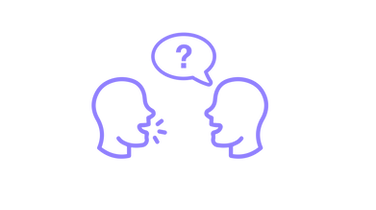A new way to communicate in foreign places.

With communication, we exchange ideas, information, and meaning. But, 40% of the world population is monolingual. And hence our communication skills are rendered useless when we find ourselves in a linguistically foreign territory.
The goal of the project was to facilitate communication in an environment where people cannot use their linguistic skills.
Project info:
12 weeks
Winter 2018
Integrated design Master Thesis
Hochschule Anhalt
Team info:
Parth Pandya
Supervisors:
Petra-Müller Csernetzky
Sandra Giegler
Design process:
Problem identification > Survey & Analysis > Data articulation > Design challenge formulation > Design Solution
Data articulation
After having identified the problem and conducting a survey among 250 monolingual participants via google forms, the data collected was purged, assorted and strategically articulated to derive design guidelines which will then aid the design process.

Age of the participants. (The size of the data represents the frequency of the number counts)

Issues faced while traveling. (The size of the data represents the frequency of the number counts)

Design challenge
The design solution

Blue card(back side) - Numbers
With numbers on the backside of the blue card, the users can communicate units/numbers as per their need. This feature is used while discerning the time or communicating the amount and money.
Enabling a 24 year old monolingual
in linguistically foreign territory to overcome
communication barrier.
Yellow card - Basic amenities
With icons like SIM card, WiFi, medicine, emergency, ATMs, users can point at the icons and ask for the required service/product. These are the icons that depict the primary needs of a visitor in a foreign place.
Blue card - Transportation
This card has icons like bicycles, taxi, trains and other types of public transportation and directions. The user can pinpoint at a particular icon and/or direction icon to ask people the whereabouts of particular means of transportation.
Green card - Dietary needs
This card holds icons like poultry, milk, fruits, fish, drinks and the like. Accompanied with a cancel icon, the user can refuse to have a particular food item when they are intolerant to any of food depicted above.

Basic needs of the participants (The size of the data represents the frequency of the number counts)

The cards can be combined to use in different environments creating different possibilities.
Upon arrival, the yellow card can be used to find ATMs or restaurants. After which, the blue card can be used to find the necessary form of transportation or directions and upon arrival at the venus, the green card can be used to order food or beverages as per the preference.
The icons on the cards are derived from the above infographics which are the result of an extensive survey conducted among monolinguals. Each icon have been carefully designed to objectively express and understand the need of the users.

As learnt from the research and Wi-Fi being the main need, the cards are designed to bridge the small space when the user is vacillating between Wi-Fi connections.

